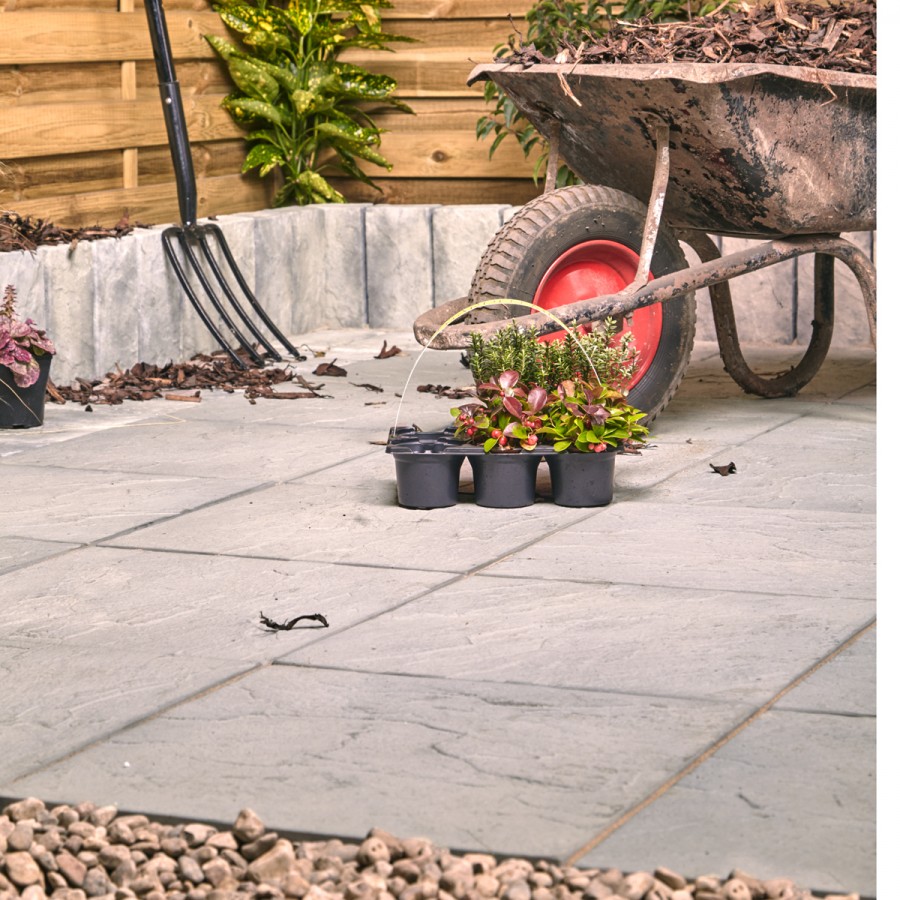
The professionals make laying block paving look easy, but with the right materials and some manual work it is not quite the major undertaking that you may of first thought. Follow this simple step by step example guide to laying a non-permeable driveway.
BEFORE YOU START...
Draw a simple plan of your home and garden, sketching where you would like areas to be paved. Once your plan has been finalised, lay out lengths of string to mark out the dimensions of your purposed patio in position. When you are happy with this, let the digging commence.
STEP 1: SITE PREPARATION
Depending on the size of the area, using the shovel or mini excavator dig out to the advised level. This will depend on your existing surfaces, our Customer Services team will be able to advise as to the appropriate depth. If you find soft spots in the soil further excavation may be required. These spots can then be filled and consolidated with sub-base material. Remove all waste materials from the site using a wheelbarrow and skip. When using excavation machinery please follow all manufacturers’ guidelines including acceptable levels of exposure and in particular use ear protection.
STEP 2: EDGE RESTRAINTS
When preparing mix, please avoid direct handling of cement, always cover your skin. Using the cement mixer, mix 1 part cement and 6 parts ballast to create a concrete foundation for the edge restraint that is 100mm thick. Ensure that the edge restraint unit that is to be placed on the foundation will sit at the required finished level using the string line and spirit level. The edge restraint can either be a kerb unit of a thick paving block (at least 60mm). Mortar these units into the foundation using the trowel and rubber mallet and again using the concrete, form a haunch up at least half the block height.
STEP 3: THE SUB-BASE
Further to your specific requirements, apply the sub-base of MOT Type 1 with the rake and thoroughly compact using the vibrating plate compactor in layers of 50mm until your desired level is reached. Apply a 50mm level of slightly damp, coarse sharp sand and compact down, again using the vibrating plate compactor, to an approximate depth of 35mm. A further 20mm layer of sharp sand then needs to be raked on top and using the screeding rails and string line, levelled to the correct falls. When using vibrating plate machinery please follow all manufacturer’s guidelines including acceptable levels of exposure and in particular use ear protection
STEP 4: INSTALLATION
Remember when lifting and carrying paving units, always consider the weight before attempting to lift. If it is heavy, take care not to trap your fingers whilst handling the paving units. Ideally starting from a right angle or straight edge, place your blocks on top of the laying course, ensuring that they sit 5mm proud of the finished level. Following your desired laying pattern ensure that you pick blocks from three or more different packs at any one time in order to minimise the risk of colour patching. Once all of the blocks are laid into position you will need to cut a number to complete the area. Cutting blocks is best done using a block splitter or diamond disc cutter. Wherever possible, always obtain water suppression cutting equipment. When using cutting equipment please follow all manufacturer’s guidelines including acceptable levels of exposure and in particular use eye protection.
STEP 5: FINISHING
Using the yard broom, brush the kiln dried sand into all of the joints and thoroughly compact, again using the vibrating plate compactor, ensuring that all of the blocks are at the desired finished level. Subsequently top the sand and re-compact to ensure that no joints are left unfilled.Please note: if you are using the Brett Aura or Classico range of paving blocks the Brett Permeable Chippings need to be applied in this finishing process.
MATERIALS AND TOOLS CHECKLIST
The key to starting off this style of project is the equipment, correct tools and materials for the job and having them all close to hand. Quantities of the following materials will vary depending on the size and sub-base requirements of your patio.
MATERIALS
- Sub-base Material (MOT Type 1)
- Sharp Sand
- Concrete and Mortar
- Brett Kiln Dried Sand
- Block Paving
TOOLS
- Trowel
- Pointing Iron
- String Line
- Rubber Mallet
- Screeding Rail
- Spirit Level
- Shovel
- Shovel
- Skip
- Wheelbarrow
- Tape Measure
- Yard Broom
- Vibrating Plate Compactor
- Block Splitter or Diamond Disc Cutter
- Mini-Excavator (Optional)
- Cement Mixer (Optional)
Please use Personal Protective Equipment when carrying out this work, such as safety shoes and gloves: Gloves, Safety Goggles, Dust Mask, Ear Defenders, Knee Pads.

